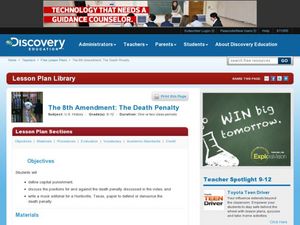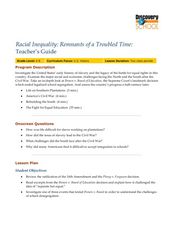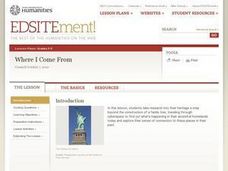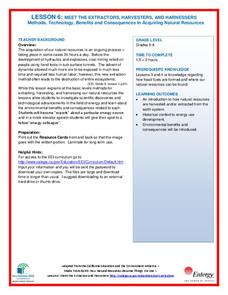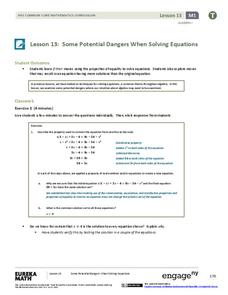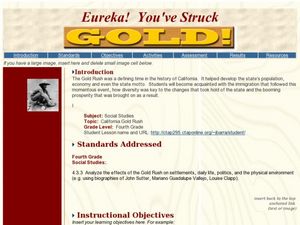Curated OER
Water and Ice
Students make observations of ice as it melts. In this phase change lesson, students observe ice as it melts in a cup. They discuss their observations and place the cup of water into a freezer to change it back into ice.
Curated OER
Quilt Squared
Students study West Virginia quilts. For this mathematics lesson, students use symmetry, geometric shapes, and patterns to create their own quilt square.
Curated OER
Greek Architecture
Students explore the Parthenon. In this lesson on Greek Architecture, students view a video on classical architecture, then split into groups to research assigned architectural elements such as capitals, columns and floors. They then...
Curated OER
The 8th Amendment: The Death Penalty
Young scholars take a closer look at the death penalty. In this U.S. government lesson, students watch a Discovery video about capital punishment in the United States and then compose letters to the editors of newspapers about their...
Curated OER
Racial Inequality: Remnants of a Troubled Time
Learners watch the Discovery program "Racial Inequality: Remnants of a Troubled Time" then examine the ratification of the 14th Amendment and the Plessy v. Ferguson decision. They research one of three events that tested Brown v. Board...
Curated OER
Moving West
Students research the Westward Movement and struggles encountered by the pioneers as they moved from Nebraska, Westward along the Oregon Trail. In this Westward Expansion lesson plan, students read an Oregon Trail poem and visit 5...
Curated OER
What is the Attraction?
Second graders investigate the law of polarity. In this magnets lesson, 2nd graders discover how magnets are used in everyday life and which objects in our environment are magnetic. Students experiment with bar magnets and record...
Curated OER
The Feudal System: Castles At War
Students create a first person account of life in the middle ages from the perspective of a king, noble, knight or peasant. They view and discuss a Discovery Channel video then research the roles and responsibilities of their class...
Curated OER
Eureka! I’ve Got an Idea!
Students explore many inventions and inventors. In this science lesson, students collaborate as they research inventors and their times in order to compile information to build an informative Web site.
Curated OER
Social Studies: Where I Come From
Students research the countries of their origins and examine life there today. They write family travel logs by interviewing family members about their heritages, and they visit the Xpeditions Website for online resources about their...
National Endowment for the Humanities
Kennewick Man: Science and Sacred Rights
"Have respect for the dead!" Scholars investigate how science and religion often clash. As they look into the laws of science and the laws of religion, the legal ramifications at the federal level of both play into an argument they...
Fredonia State University of New York
Watch Your Step…You May Collide!
Can two lines intersect at more than one point? Using yarn, create two lines on the floor of the classroom to find out. Cooperative groups work through the process of solving systems of equations using task cards and three different...
National Wildlife Federation
Meet the Extractors, Harvesters, and Harnessers: Methods, Technology, Benefits and Consequences in Acquiring Natural Resources
There are advantages and disadvantages to all sources of energy; the trick is determining which one has the least impact! Part six in the series of 12 has learners further explore energy resources. After reading information about one of...
Federal Reserve Bank
Purchasing a Vehicle
Start your engines! Prevent negative car buying experiences by arming pupils with information. Prepare your young drivers to make informed decisions when they are ready to purchase a car. All aspects are considered from the type of car...
EngageNY
Drawing a Conclusion from an Experiment (part 1)
Challenge your classes to complete an experiment from beginning to end. Learners make their own hypotheses, collect and analyze their own data, and make their own conclusions. They are on their way to becoming statisticians!
Curated OER
Origin of the Modern Summer Games
Where did the Olympic Summer Games originate? The class takes a look at ancient origins of modern Olympic games. They research the Olympics and write a compare and contrast essay that describes how the Olympic Games have changed since...
EngageNY
Sampling Variability in the Sample Mean (part 1)
How accurate is data collected from a sample? Learners answer this question using a simulation to model data collected from a sample population. They analyze the data to understand the variability in the results.
EngageNY
Some Potential Dangers When Solving Equations
Need a less abstract approach to introducing extraneous solutions? This is it! Young mathematicians explore properties used to solve equations and determine which operations maintain the same solutions. They...
EngageNY
Composition of Linear Transformations 2
Scholars take transformations from the second to the third dimension as they extend their thinking of transformations to include three-dimensional figures. They explore how to use matrices to represent compositions of...
Curated OER
Tissue Paper Flowers
Here is a sweet and simple lesson that introduces young learners to the three primary colors; red, yellow, and blue. Through a discovery process, youngsters learn how to successfully identify these colors, and the many shades of these...
Curated OER
The Birds of a Feather Flock Together
Fifth graders identify all parts of an egg, and explore their importance to the life cycle of a chicken. Learners compare all sorts of birds and place them in categories based on what they look like. This five-day activity effectively...
Curated OER
Exploring the Sky: Reading Maria's Comet
Discover the science behind astronomy. After reading the book Maria's Comet, which is about a young woman who breaks new ground by becoming a female astronomer, young learners practice reading comprehension with...
Curated OER
Eureka! You've Struck
While incomplete, this lesson could provide ideas for a lesson on the California gold rush. Learners look at a chart to analyze population growth in San Francisco after the discovery of gold, analyze political changes that occurred, and...
Curated OER
Fresh Foods from Farm to Table
Are you a good egg? Learners begin a farm-to-table lesson by acting out verbs in groups to demonstrate the egg production process, and then research the steps using online resources. Several excellent videos are linked through the...



